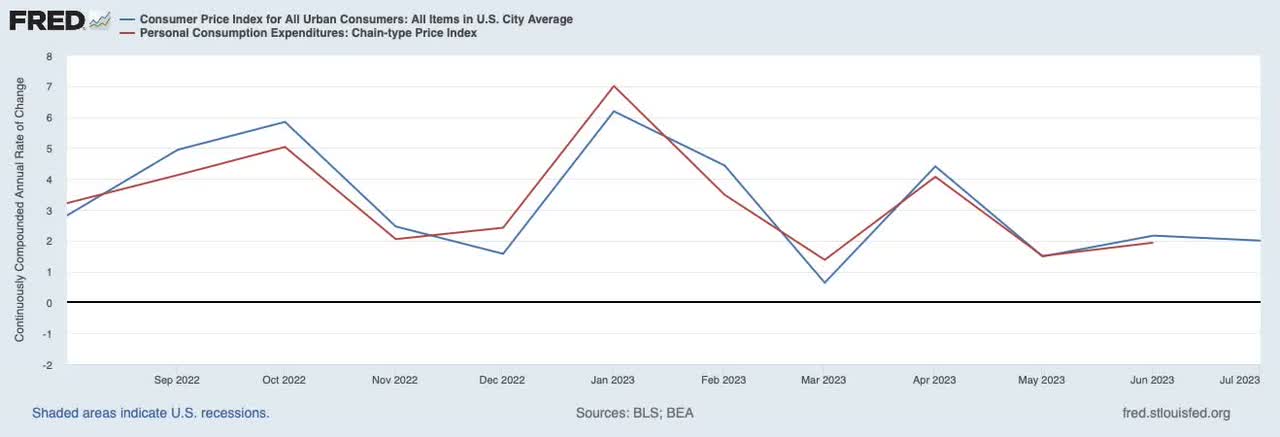By William J. Luther
With inflation now much lower than it was a year ago, many pundits are considering where the Federal Reserve should go from here. Nick Timiraos surveys three options in The Wall Street Journal:
Option 1: Fed officials can raise rates higher to bring inflation down to 2 percent quickly.
Option 2: Fed officials can hold rates at their current level (and consider trimming rates later next year) to bring inflation down to 2 percent slowly.
Option 3: Fed officials can replace their 2 percent target with a 3 percent target and declare victory.
Let me offer a fourth option: Hold rates where they are and declare victory now.
The Fed does not need to raise rates further. And stopping now doesn’t amount to stopping short because inflation is already at or around 2 percent.
As noted in its Statement on Longer-Run Goals and Monetary Policy Strategy, the Fed judges “that inflation at the rate of 2 percent, as measured by the annual change in the price index for personal consumption expenditures, is most consistent over the longer run with the Federal Reserve’s statutory mandate.” And, although it says “appropriate monetary policy will likely aim to achieve inflation moderately above 2 percent for some time” when “inflation has been running persistently below 2 percent,” it does not indicate that it will let inflation run below 2 percent following periods when prices have grown more rapidly. In other words, the Fed has an asymmetric average inflation target and – since inflation has been relatively high over the last three years – should only be expected to bring inflation back down to 2 percent.
Inflation is commonly reported over a 12-month period. Over the 12-month period ending in July 2022, the personal consumption expenditures price index (PCEPI) grew 6.38 percent, while the consumer price index (CPI) grew 8.41 percent. The CPI grew 3.30 percent over the 12-month period ending July 2023. The PCEPI for July has not yet been released, but it grew 2.97 percent over the 12-month period ending June 2023. Taken together, these numbers seem to imply that the Fed has more work to do if it is to get inflation back down to 2 percent.
Not so fast! The 12-month rate tells us how much prices have risen over the last 12 months. But what really matters for determining the appropriate course of monetary policy is (i) how much prices have been rising recently and (ii) how much they are likely to rise going forward given the current state of policy.
Over the last three months, the CPI has grown at an annualized rate of just 1.88 percent. It grew at an annualized rate of 1.49 percent in May, 2.16 percent in June, and 2.00 percent in July. The PCEPI grew at an annualized rate of 1.50 percent in May and 1.94 percent in June. It will likely come in at or around 2 percent in July.
An annualized monthly rate tells us how much prices will rise over the next 12 months if prices continue to rise at the same rate. That’s not quite the same as how much prices are likely to rise going forward given the current state of policy, but it is a good place to start. To estimate how much prices are likely to rise going forward given the current state of policy, one must also consider whether monetary policy is loose, tight, or neutral at present (and is expected to remain so into the not-so-distant future).
One common way to gauge the stance of monetary policy is to see whether the Fed’s real (inflation-adjusted) policy rate is greater than (tight), less than (loose), or equal to (neutral) the natural rate of interest, which is often denoted R* or r-star. The New York Fed offers two estimates of the natural rate. Its Holston-Laubach-Williams estimate is 0.58, whereas its Laubach-Williams estimate is 1.14 percent. The Richmond Fed presents its own estimate, known as the Lubik-Matthes natural rate, which is 2.16 percent.
The Fed’s nominal policy rate range is 5.25 to 5.5 percent. Since inflation is around 2 percent, the real policy rate range is roughly 3.25 to 3.5 percent. Given the aforementioned estimates of the natural rate, that suggests that policy is moderately to extremely tight. In other words, one should expect inflation to fall even further (i.e., below 2 percent) if the Fed holds rates where they are.
The battle for 2 percent inflation has already been won. Fed officials should acknowledge and celebrate the victory. Further rate hikes risk unnecessary casualties.
Original Post
Editor’s Note: The summary bullets for this article were chosen by Seeking Alpha editors.
Read the full article here












